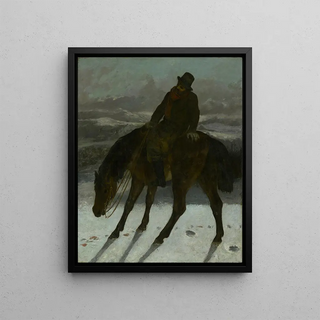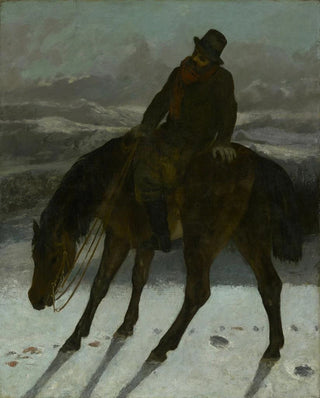Art print | Horseback Hunter - Gustave Courbet


View from behind

Frame (optional)
In the vibrant universe of art, some works stand out for their ability to capture the spirit of a particular era while resonating deeply with the human soul. "Chasseur à cheval" by Gustave Courbet is one such creation. Created in 1845, this iconic canvas transcends the simple frame of painting to become a true ode to nature and freedom. By placing a rider at the heart of his landscape, Courbet invites us to contemplate not only the subject but also the relationship between man and his environment. This piece, rich in emotion and symbolism, embodies the spirit of a time when nature was seen as a space of liberty and escape.
Style and uniqueness of the work
Gustave Courbet's style is often associated with realism, an artistic movement advocating a faithful representation of reality. In "Chasseur à cheval," this approach is expressed through meticulous details and a palette of earthy colors that evoke the rusticity of the landscape. The rider, with his attitude both determined and contemplative, seems to harmoniously blend into this natural setting. The way Courbet plays with light and shadow adds an almost tactile dimension to the scene, allowing the viewer to feel the gentle breeze and the scent of damp earth. The composition, though seemingly simple, reveals an emotional depth that invites reflection on the human condition and our relationship with nature.
The artist and his influence
Gustave Courbet, an emblematic figure of the 19th century, left a mark on art history through his boldness and desire to depict reality without embellishment. By challenging the academic conventions of his time, he paved the way for many artists who followed in his footsteps. His commitment to realism not only redefined aesthetic standards but also influenced subsequent movements, such as Impressionism. "Chasseur à cheval" fits within this lineage of artistic rebellion, where the artist does not seek to idealize his subject but to reveal its raw truth. Courbet, through his unique vision, was able to capture the very essence of human experience, making each canvas a mirror of the society of his era.

Matte finish

View from behind

Frame (optional)
In the vibrant universe of art, some works stand out for their ability to capture the spirit of a particular era while resonating deeply with the human soul. "Chasseur à cheval" by Gustave Courbet is one such creation. Created in 1845, this iconic canvas transcends the simple frame of painting to become a true ode to nature and freedom. By placing a rider at the heart of his landscape, Courbet invites us to contemplate not only the subject but also the relationship between man and his environment. This piece, rich in emotion and symbolism, embodies the spirit of a time when nature was seen as a space of liberty and escape.
Style and uniqueness of the work
Gustave Courbet's style is often associated with realism, an artistic movement advocating a faithful representation of reality. In "Chasseur à cheval," this approach is expressed through meticulous details and a palette of earthy colors that evoke the rusticity of the landscape. The rider, with his attitude both determined and contemplative, seems to harmoniously blend into this natural setting. The way Courbet plays with light and shadow adds an almost tactile dimension to the scene, allowing the viewer to feel the gentle breeze and the scent of damp earth. The composition, though seemingly simple, reveals an emotional depth that invites reflection on the human condition and our relationship with nature.
The artist and his influence
Gustave Courbet, an emblematic figure of the 19th century, left a mark on art history through his boldness and desire to depict reality without embellishment. By challenging the academic conventions of his time, he paved the way for many artists who followed in his footsteps. His commitment to realism not only redefined aesthetic standards but also influenced subsequent movements, such as Impressionism. "Chasseur à cheval" fits within this lineage of artistic rebellion, where the artist does not seek to idealize his subject but to reveal its raw truth. Courbet, through his unique vision, was able to capture the very essence of human experience, making each canvas a mirror of the society of his era.






